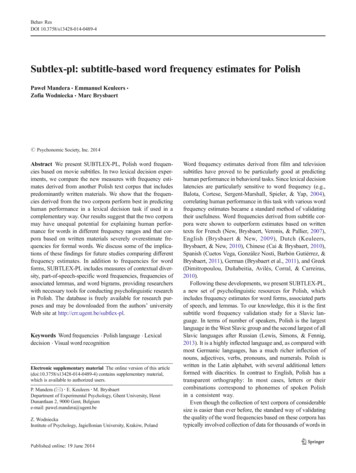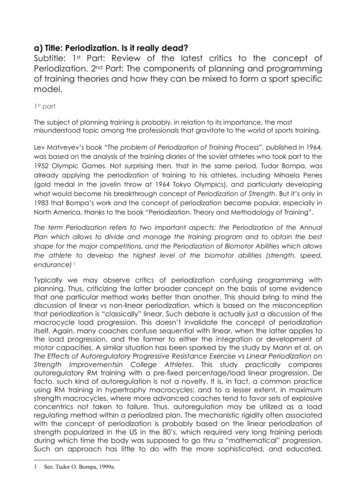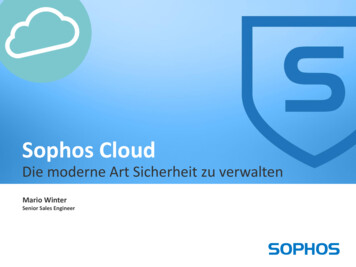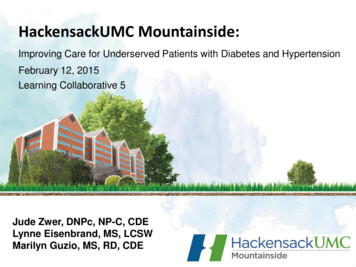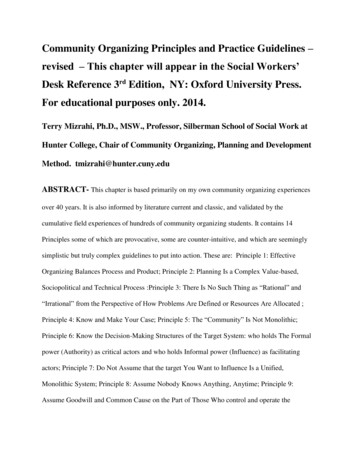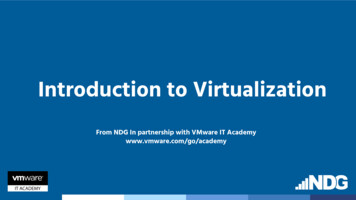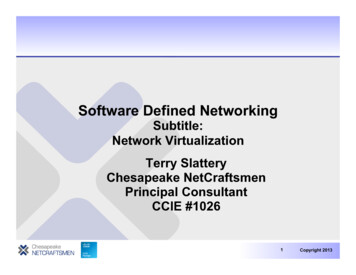
Transcription
Software Defined NetworkingSubtitle:Network VirtualizationTerry SlatteryChesapeake NetCraftsmenPrincipal ConsultantCCIE #10261Copyright 2013
What is Virtualization? VirtualExisting or resulting in essence or effect though not inactual fact, form, or name: the virtual extinction of thebuffalo. (The Free Dictionary)Not physically existing as such but made by softwareto appear to do so: "virtual images". (Google) Something that you can use as if it were real.– Virtual memory and virtual disks are used as if theyare real, but are built from multiple underlyingcomponents that may be different than the physicalentities.– Driven by queuing theory: shared resource pools aremore efficiently utilized than individual pools2Copyright 2013
Memory Virtualization Precursor was memoryoverlays– Programmer designed overlaysand controlled transitions VM made programming moreefficient– Automatically handled loadingdata and instructions into RAM– LRU algorithms balancedinefficiencies of manual tuning– Programmer efficiency increased– Abstraction on top of physicalmemory Hides complexityWikipedia Image3Copyright 2013
Disk and Storage Virtualization In the old days ––––Similar to old memory allocation mechanismsAdmins specified disk partitions & assigned dataRequired advanced planning and usage estimatesChanging partition size was a manualprocess Virtual disk partitions– Resize by adding/removing slices– Increase of administrator efficiencyoffsets mapping to physical disk– Storage abstraction on top ofphysical disk space Hides complexity4Copyright 2013
CPU Virtualization Large resource pool drivesgreater usage efficiencyoracle.com Abstraction of VirtualMachines running onphysical computeclusters Use of “stock” OSinstallations improvessystem administratorefficiencies Hides complexity5Copyright 2013
Combining pyright 2013
What About Network Virtualization? L2 (Ethernet example)–––––Start with coaxMulti-port transceivers (Cabletron)Multi-LAN chassis (Cabletron)VLANsQ in Q, VXLAN, NVGRE, etc L3– MPLS (and other L3 tunnel technologies) L2-L4 abstraction - simplifies networks andhides complexity?7Copyright 2013
Data Plane Abstractions OSI data layering model Some inefficiency Simplifies design andimplementation Hides details and complexity oflower rkData LinkPhysical8Copyright 2013
Control Plane Abstractions No layering Complexity is not hidden Baroque interfaces between protocolsSTP9Copyright 2013
Combining Network Virtualization Needed: control plane data plane abstractions– Create a L3 domain to handle Internet HTTP to Nservers in data center 1, with basic security and loadbalancing– Add/remove servers to the Internet HTTP domain asload changes Opportunity:Merge with compute virtualization?– More powerful and more useful abstractions– Implies greater ease of use (lower admin effort/cost)10Copyright 2013
What Is SDN? Network virtualization–––––––Create control plane abstractionsHide complexityCleaner interfacesCost: some network efficiency lostBenefit: Stability, efficiency of useThink: VMware for networkingDecoupling the logical from physical resourcesThe future of networking lies in cleanerabstractions.SDN is merely a set of abstractions for thecontrol plane.– Scott Shenker11Copyright 2013
OpenFlow SDN started with OpenFlow API to allow apps to program forwarding tablesin switches Relatively new protocol– ACM paper by Nick McKeown, OpenFlow: Enablinginnovation in campus networks, April 2008– OpenFlow 1.0: Dec 31, 2009– OpenFlow 1.3.1: Sept 2012 Centralized controllers are not newOpenFlow doesn’t let you do anything youcouldn’t do on a network before.” – ScottShenker12Copyright 2013
OpenFlowOpenFlow is an openstandard that enablesresearchers to runexperimental protocols inthe campus networks weuse every day.- openflow.orgopenflow-spec-v1.1.013Copyright 2013
OpenFlow Processingopenflow-spec-v1.1.014Copyright 2013
OpenFlow Packet Forwarding Enginesdncentral.com Match, Action– Actions: forward, drop, push/pop a new header,modify header fields, or forward to controller Counters kept on all flow entries15Copyright 2013
OpenFlow Designed for ResearchOpenFlow is an open standardto deploy innovative protocolsin production networks.16Copyright 2013
Will OpenFlow Scale for Production?17Copyright 2013
OpenFlow Limitations Insufficient functionality– Need non-flow configuration (see OF-Config 1.1)– Need new abstractions to simplify networking andreduce the potential for errors Scaling problems– Per-flow processing in a big DC (10M flows/sec?)– Multiple control points (flow rate X control points)– TCAM size limits (particularly in ToR switches)(bradhedlund.com & ioshints.info)– Scaling mechanisms will need to be developed18Copyright 2013
What Is SDN? Means different things to different people It is NOT OpenFlow! It is a paradigm shift My definition – High level abstraction of the control plane– Virtualize the network– Can work with the network on a conceptual basiswithout mapping to the physical elements Implication: It changes the deployment andbusiness models19Copyright 2013
True Network VirtualizationMidoNet solution diagram provided by Midokura20Copyright 2013
SDN AnatomySDN ControllerSystemSimple PacketForwarding EnginesScott Shenker, ONS’11 talk21Copyright 2013
Network Virtualization Migrate L2-L4 along with the VM– Migrate Load Balancers and Security It’s why VMWare bought Nicira for 1.2B Example:– How does traditional SNMP counter handling workwith VM migration?– Need to move counters along with the CPU, Memory,Storage, and Network22Copyright 2013
SDN Guidelines Handle complexity (ACL, QoS, mobility) at theedge (in vSwitches) Overlay the physical network with a virtualnetwork Switches may use tunneling to forward packets Don’t need to upgrade your hardware switches Controller is logically centralizedWe’ll see how this turns out 23Copyright 2013
SDN Hype Centralized management and control ofmulti-vendor networks––––Redundant controllers - split brain operationIn-band or dedicated management network?What about linecard protocols (e.g., BFD)?Scaling issues to be identified and solutionsdeveloped Uniform policy deployment– Requires uniform policy definitions– Existing configuration management systemsmarginally successful; changing the mechanismwon’t fix it– UI and API to define policy and exceptions– Better QoS and TE configurations?24Copyright 2013
SDN Hype Fewer configuration errors– Errors propagate faster; bigger impact– Controllers must be smarter to avoid common errors– Configuration library is needed Similar to software development abstractions Eliminate sources of errors Increase scalability and optimum forwarding– Per-flow forwarding decision making doesn’t scale RTT to controller is too expensive Fallback operation if controller doesn’t respond Use aggregate flow entries Other optimizations To Be Developed25Copyright 2013
SDN Hype Integrated security––––It Depends How complete a solution? Pure OpenFlow?Basic security is possibleVirtual appliances with a virtual network overlay area more complete solution Load balancing– Load balancer built in 500 lines of codeYouTube: Aster*x: Load-balancing as a network primitive, NikhilHandigol– No additional hardware; just “smart routing”26Copyright 2013
SDN Hype Per-tenant QoS– Certainly at the edge– Must still handle shared BW on aggregation links Expect vendor extensions– Differentiation between vendors– Customer lock-in27Copyright 2013
Is SDN a Fad? East-West flows dominate DC traffic Shared resource pool is more efficient Rate of change at the edge is increasing– But the network’s ability to effect change is lagging Need automated, multi-vendor methods fornetwork configuration management– CLI isn’t sufficient28Copyright 2013
What I See Coming SDN is not a fad– It will be different than the current hype Good benefits Worth the pain of transition– The current pain makes it worth the transition Hides network complexity (doesn’t reduce it) Don’t throw out good network design practices Managing an SDN will be different29Copyright 2013
System View of the Network We’ve needed a system view of the network– Difficult with device-centric systems Logically-centralized system– Central point of control– Should be physically distributed Examples:– Network-wide QoS with a consistent UI– Load balancing when and where you need it30Copyright 2013
Improved Traffic Engineering Central view of traffic engineering––––Direct traffic where you want it and via which linksRouting protocols “pull” trafficPolicy routing is too manual and device-centricGoogle improved WAN utilization (40% to 90% ) Load distribution over many paths– Central controller can use historical flow information31Copyright 2013
New Protocol Development1. Intercept OpenFlow messages (both directions)2. Policy check– Which slice?– Valid operation?3. Forward message(rewrite if needed)4. Pass returnmessages to thecorrect controllerFlowVisor: A Network Virtualization Layer32Copyright 2013
Rapid Provisioning and Migration What’s your provisioning time? Migration time? Building an agile data center UI API to provision CPU, Memory, Storage, &Network together Easily move workloads for energy savings– Turn off unused switch ports as well as servers33Copyright 2013
Use Cases – Reduce Data Center L2 Reduces the need for large DC L2 domains Overlay L2-L4 overa well-designednetwork34Copyright 2013
Use Cases – Multi-tenant Networks Use their own L3 addressing Virtual overlay networks Dynamic remapping of the ports in the virtualnetworks Avoids VLAN number exhaustion Alternatives can bemade to work– VXLAN, NVGRE– Aren’t ascomprehensiveTenant 1Tenant 2Tenant 335Copyright 2013
Other Use Cases Energy reduction practices– opennetworking.org video IPv6 address tracking– ioshints.info tip SPAN traffic selection and director Provisioning for Big Data analysis Observation: multiple technologies to addressthe suite of use cases36Copyright 2013
Integration With the Rest of the Network Run L2 or L3 protocols at the edge– SDN cloud can look like one router/switch– Controller runs routing protocols– Switches forward routing protocol packets tocontroller– Expect “interesting” failure modes and bugs37Copyright 2013
Troubleshooting Will Change Controller connectivity problems– In-band path to switches Connectivity may need to be repaired first diagram of problem? – Out of band path to switches Separate network to provision and manage Use SDN with in-band communications on controlnetwork? (Vicious cycle?)– Split brain situations38Copyright 2013
Do We Need SDN? Network Configuration––––Manual processes don’t scaleLong deployment timesInconsistent policy implementationMulti-vendor, typically via CLI, is hard Multiple technologies to achieve similarsolutions– Interactions between andsupport of the technologies– Layering functions on top ofone another; additional complexity39Copyright 2013
Will SDN Eliminate Jobs? Not likely Daily workload will change– Software and scripting experience will help Shift to more valuable tasks40Copyright 2013
Proof of Concept Begin experimenting with SDN–––––Begin learning some of the lessonsEvaluate controllers and switchesImprove corporate IT systems agility 100K - 500K cost (switches, controller, staff cost)Ongoing platform for evaluating and debuggingnetwork-aware apps Begin organizational transition– Culture– Developing lines of communication– Proactive adoption41Copyright 2013
Predictions Some SDN protocols will run in the networkdevice– Local decisions for non-stop operation,performance, and scaling– Line card protocols will run locally, communicatingwith SDN controller Scaling issues will be addressed– May operate like IPmc – flow starts on the defaultpath, then switches to the optimum path. Virtual networks will simplify the common case New failure modes and troubleshooting tips Widespread adoption in 5 years42Copyright 2013
Questions I Have What do the controller abstractions look like?– Defining a group of devices/interfaces to apply apolicy– What do policies look like? Set all interfaces with characteristic X to 100/Full Map flows to web server Y to distributed cluster Z Apply QoS/security policy to all interfaces like X System monitoring and management– SNMP isn’t sufficient - slow to develop/change– Do the abstractions match?– How are error conditions reported?43Copyright 2013
Summary SDN is a disruptive technology It will look different than it does today New design rules, new challenges Big changes ahead It will be an exciting journey44Copyright 2013
Questions? Further Reading – http://www.nec-labs.com/ lume/sdn-reading-list.html– Network Virtualization bradhedlund.com blog.ioshints.info Scott Shenker – Gentle Introduction to SDN(YouTube)– OpenFlow opennetworking.org– Georgia Tech SDN MOOC – coursera.com– “Enterprise Data Center Security with SoftwareDefined Networking” – IBM pdf– http://www.imsaa.org/tutorial 4.pdfTerry SlatteryChesapeake Netcraftsmen45Copyright 2013
OpenFlow 12 SDN started with OpenFlow API to allow apps to program forwarding tables in switches Relatively new protocol – ACM paper by Nick McKeown, OpenFlow: Enabling innovation in campus networks, April 2008 – OpenFlow 1.0: Dec 31, 2009 – OpenFlow 1.3.1: Sept 2012 Centralized controllers are not new
